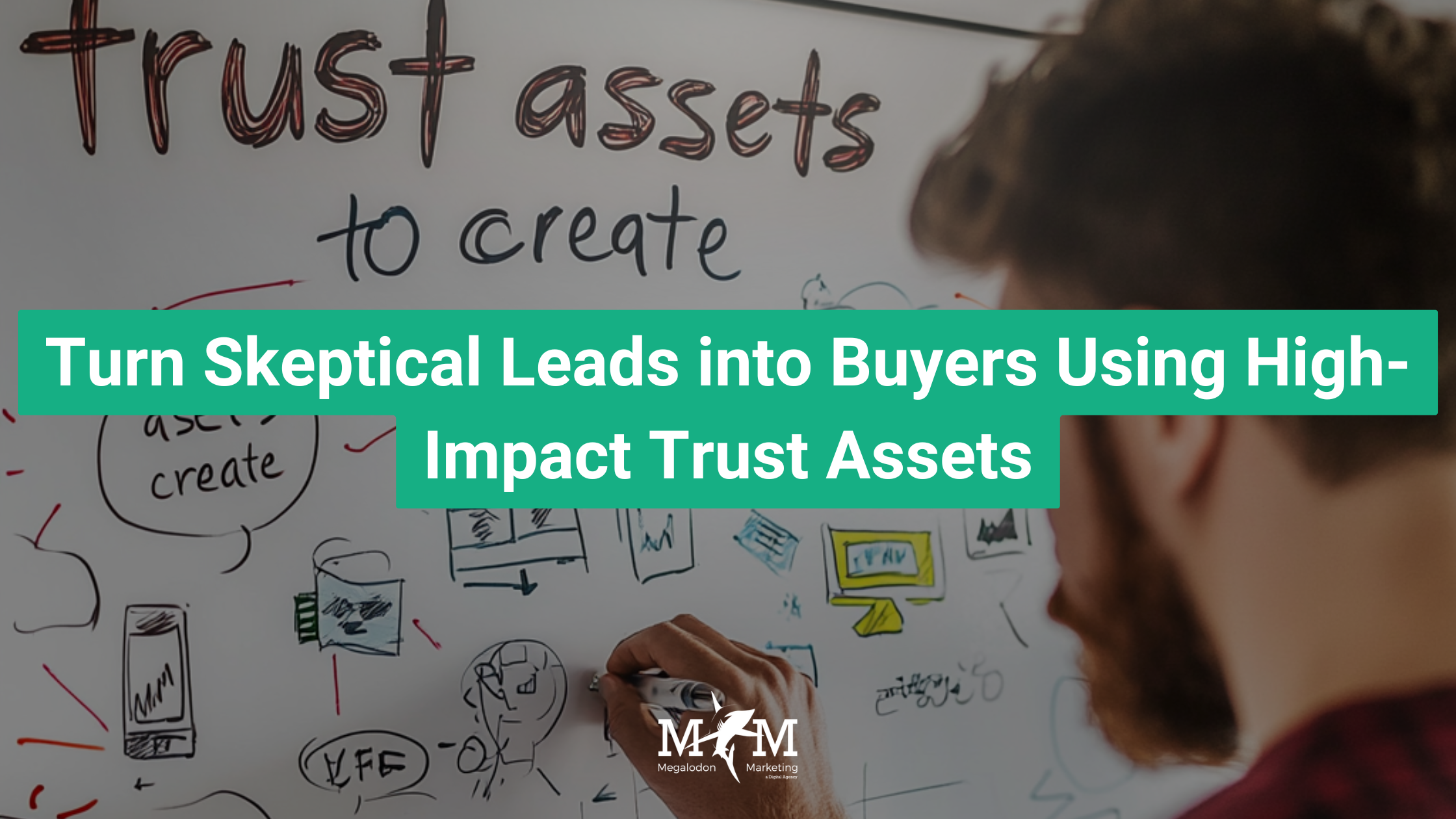I hope you enjoy reading this blog post. If you want my team to just do your marketing for you, click here.

I hope you enjoy reading this blog post. If you want my team to just do your marketing for you, click here.
Author: Jeremy Haynes | founder of Megalodon Marketing.

Earnings Disclaimer: You have a .1% probability of hitting million dollar months according to the US Bureau of Labor Statistics. As stated by law, we can not and do not make any guarantees about your own ability to get results or earn any money with our ideas, information, programs or strategies. We don’t know you and, besides, your results in life are up to you. We’re here to help by giving you our greatest strategies to move you forward, faster. However, nothing on this page or any of our websites or emails is a promise or guarantee of future earnings. Any financial numbers referenced here, or on any of our sites or emails, are simply estimates or projections or past results, and should not be considered exact, actual or as a promise of potential earnings – all numbers are illustrative only.
Key Takeaways (Read These First)
Selling something expensive—especially in that coveted “high-ticket” range—can’t rely on the same old strategies that might work with a $97 product or a basic service subscription. When you’re looking at deals where people are investing $75,000, $200,000, or even $1 million plus, skepticism goes through the roof. Buyers in these ranges have often encountered scams, shady providers, or unsubstantiated claims. They don’t move forward just because your copy is snappy. They need proof, delivered in a credible way.
Modern buyers are better informed and more cautious than ever. The good news? They’re also actively looking for reasons to trust you. If you can present them with the right combination of data, real examples, and verified third-party evidence—what I call high trust consumables—you gain a decisive advantage. That advantage drastically condenses your sales cycle and puts you in pole position to close deals quicker.
Throughout this article, I’ll show you how to deploy these “trust assets” step by step, drawing on real-world client examples that raised millions of dollars in capital, sold high-ticket products like sophisticated red-light therapy systems, and overcame heavy skepticism in the information product and coaching space. By seeing how it all comes together—especially with advanced strategies in the raising-capital niche—you’ll get an action plan to apply in your own business, no matter what you’re selling.
Before diving deeper, let’s define these terms. A sales asset is any piece of content or resource that directly moves a lead closer to purchasing. Think pitch decks, ROI calculators, or a pivot table showing how investors made out in their previous deals. A trust asset, on the other hand, is anything that creates or reinforces credibility, proving you’re legit and that your claims aren’t empty hype. This could be a verifiable third-party study, an independent news piece praising your company, a robust and uncensored Reddit thread full of genuine experiences, or a well-documented case study.
Both are crucial. The sales asset structures your offer, clarifies your solution, and presents the deal. The trust asset bypasses the “But can I believe these guys?” thought that lingers in a lead’s mind. If you neglect either one, you risk losing out on big sales.
The capital-raising niche is an ideal case study because nothing triggers skepticism like a million-dollar minimum. When you’re dealing with accredited investors and families who have $5 million or more in liquid capital, they’re used to thoroughly vetting everything. They won’t just jump on a phone call and hand over large sums. There’s a multi-step process that can take weeks or even months.
I’ve worked with a particular Registered Investment Advisory (RIA) that set its minimum at $1 million per investor. About 46% of their leads showed they had $5 million or more. Some had over $100 million. This means dealing with executives, politicians, celebrities, or wealthy individuals from every corner of the globe. Getting them to believe in your offer means systematically dismantling skepticism at each stage.
But it’s not just phone calls. There are often 12 key meetings before someone invests. From brief 15-minute check-ins to full-blown financial presentations, each one addresses a new layer of questions.
Sometimes you need 20 attempts just to establish contact. High-net-worth leads might ignore emails, calls, or text messages until they’re truly convinced you’re worth their time. Once you do connect, you may have up to a dozen deeper conversations before the final decision is made.
During these calls, you’re covering everything from the viability of the investment opportunity, to track records, to any potential moral or ethical considerations. Because the average timeline can stretch 1 to 6 months, you must have multiple trust assets ready to go, each tailored to a different step in the buyer’s journey.
Let’s talk about the hidden issue with “reviews.” Five or ten years ago, you could point to your glowing Trustpilot or Google Reviews and feel accomplished. But people caught on. They know all too well these can be manipulated or deleted by shady providers. There are entire services dedicated to scrubbing negative reviews from platforms. And your savvy prospect knows it.
While local businesses can still get value out of a healthy Google My Business presence, higher-ticket buyers have learned not to treat those five-star ratings as gospel. They ask themselves, “Is this real, or is it purchased fluff?”
One marketer I know bragged about being paid $15,000–$25,000 just to remove negative Trustpilot reviews. As soon as people catch wind of that, your 4.9-star average might suddenly look suspicious. Hence the rise of new forms of trust validation—like genuine third-party data and unbiased consumer-driven forums (e.g., Reddit).
For some niches, legitimate third-party data is a goldmine. Let’s say you’re selling a high-ticket red-light therapy device. You can cite independent university studies, lab findings, or scientific journals demonstrating the health benefits of red-light therapy. When those claims come from recognized labs or respected medical professionals who aren’t connected financially to your business, it carries more weight.
I also have a client who funded an academic study to measure the success rate of cutting out alcohol in relation to participants’ personal finances and well-being over a full year. Because it was meticulously run by a reputable university, the data they publish is bulletproof. Now, when they say their program has over a 90% success rate, that statistic hits different. It’s an unshakable trust asset, validated by an independent party.
In the information product world especially, Reddit has emerged as the modern place for real-talk reviews. People don’t trust traditional platforms anymore, so they’ll literally type your product name plus “Reddit” into Google. If you haven’t started a thread for your customers to share genuine experiences, you run the risk of a “hater” or competitor initiating that conversation first—and dominating it.
Take a high-ticket coaching program I advised. Their cost was $25,000, but they relied on Trustpilot. One day, their show-up rates to sales calls dropped. Their close rate dipped. It wasn’t seasonal. It wasn’t the economy. It turned out that two negative Reddit threads—each started by individuals who never bought the course but hated the idea of courses in general—were the top results on Google. Once we discovered this, the solution was obvious: create a brand-owned Reddit thread, invite real customers to share their stories, and let the results speak for themselves.
Over 200 students posted honest feedback. Yes, some had average or middling experiences, but the majority raved about the program. Within a couple of weeks, that new thread climbed in search rankings, overshadowed the haters, and the close rate shot back up—ultimately surpassing the old benchmarks.
High-ticket e-commerce products—like red-light therapy beds or advanced panels—depend on real research. While a typical $19.99 gadget might be an impulse buy, a $25,000 therapy device requires serious proof. Independent labs, universities, or even specialized medical sites that compare red-light devices can verify your claims. Sharing these studies in your funnel or via drip emails prior to a sales call dramatically softens skepticism.
Online education is polarizing. Many prospective buyers worry about being scammed or sold an overhyped dream. That’s where you, as the seller, either gather genuine testimonials or direct leads to your Reddit or community-led conversation. The more real and unedited the experiences, the more credible. If you don’t proactively do this, course haters can hijack the narrative. One negative Google result can sabotage your entire pipeline.
Consider a Dubai-based service charging $25,000. For a while, their cost per booked call, show rate, and close rate were stable. Then, from out of nowhere, they saw a sudden drop-off in attendance and new sales. After exhaustive attempts at improving best practices, they realized a random Reddit thread dominated the Google search results when prospects tried to verify them. Every commenter in that thread slammed courses—none had actually bought the program.
They quickly responded by launching their own thread, emailing clients a direct link, and politely asking them to share genuine experiences. Hundreds responded. Within weeks, the new, positive conversation became the top search result, and performance metrics soared back. This underscores the importance of leading with your own curated high-trust consumables—especially on platforms people trust.
Now, let’s look at another capital-raising scenario that hits home how essential it is to substantiate big claims.
One client claimed a 28% cash-on-cash return annually for luxury RV, boat, and storage real estate projects. That’s more than double the S&P 500’s average 11% over the past 20 years. Skeptical? Of course. Especially because they were offering liquidity within two years, allowing people to pull out their investment in a relatively short window.
The claim alone was worthless until they proved it. So they compiled an Excel pivot table that listed every investor, the amount invested, how long until they got their capital back, and their actual net returns. They anonymized investor details for privacy but showed indisputable proof of performance. They also highlighted the reinvestment rate: out of 157 total investors, 156 had reinvested in subsequent projects. They showed exactly how these reinvestments compounded over time.
When you reveal data like that—particularly to leads who might doubt your entire premise—it’s a total game-changer. It’s a perfect example of a combined sales asset and trust asset: the pivot table demonstrates how the deal works (sales asset) and the factual returns (trust asset).
Of course, once you show that much success, the next question is: “If you’re already so successful, why are you raising outside money?” That’s where an additional vision asset entered the mix. The founders shot a clear, detailed video at one of their properties, explaining their broader plan to seize the market before competitors. They also described how they saw an opportunity to scale from raising $2–$3 million for individual properties to raising $60 million for multiple.
Each time a new skeptic question popped up, they addressed it in a thorough piece of content:
The result? A pipeline of leads who felt they had everything they needed, each question being systematically handled without the sales team having to answer the same query a thousand times on calls. That’s how you shorten the cycle from first touch to wire transfer.
Now that you understand the variety of trust assets available, realize that presentation timing is everything. Even the best content can be wasted if you throw it at your leads out of order.
Never do the “random carpet bomb” approach where you shower a lead with every piece of proof all at once.
Buyers absorb information step-by-step. They typically start with, “Who are you?” then move to “How can you help me?” and then “Prove it.” Only once they’re satisfied with that do they ask, “What are the terms?” or “How exactly does it work?” The better you can match your trust assets to each stage, the more efficient and persuasive your approach becomes.
A few standard ways to deliver your trust assets in sequence include:
In other words, map out your leads’ usual journey, anticipate their biggest questions, and design trust assets to address each.
Transforming a single trust asset into multiple formats allows maximum reach and impact. A comprehensive pivot table can morph into:
The same is true for third-party research (like a university study on your product) or well-documented testimonies in your brand-owned Reddit thread. Chop it up into short videos, incorporate snapshots of the study’s conclusion in your emails, or embed the entire PDF for those who want to dig deeper.
One thing you’ll hear me say frequently: your leads are searching for reasons to buy—or not to buy. It’s your responsibility to present strong, transparent proof that your solution works. If you lack that evidence or don’t put it in front of them at the right moment, you empower them to say no.
Since buyers do independent research, you want your own official trust assets ranking in search engines. Proactively address that by:
The real secret to unstoppable high-ticket sales is replicating the phone sales process before the call. That way, by the time the prospect actually speaks to your closer (or you), the main objections are already handled and the trust is pre-built.
Imagine if your call times got cut in half because each lead already understood:
Now, each conversation is a layup—where the only question left is, “When do we start?”
Adapting to these modern trust assets is non-negotiable for anyone selling high-ticket products, services, or investment opportunities. As the marketplace becomes savvier—and as old-school review platforms become less reliable—you’ve got to proactively present proof that addresses every objection:
By systematically removing fear and skepticism, you transform your leads from anxious onlookers into informed, excited buyers. That’s how million-dollar deals and high-level transactions happen at scale.
Remember: If someone’s on the fence about giving you $75,000… $900,000… or even $1 million, that decision only comes when they see undeniable proof that you’re worth it. High trust consumables are how you deliver that proof. Use them effectively, and watch your conversions soar.
In my world of guiding businesses to seven and eight-figure monthly revenues, the difference between a slogging, stressful sales process and an efficient, profitable one often comes down to how well you handle skepticism. Implementing the tactics outlined here—pivot tables, third-party studies, brand-owned Reddit threads, investor success stories, or thoroughly documented case studies—equips you to turn cynics into superfans.
No matter your niche, these strategies are universal. They’ve worked for RIAs with $23 billion under management, high-ticket red-light therapy producers, multi-million-dollar capital raisers, and global coaching programs offering $25,000 packages. They’ll work for your business, too, once you fully integrate them and deliver them in the right sequence.
Now it’s your turn to take the blueprint and implement it into your funnel, your follow-up, and your phone calls. Once you do, you’ll see how quickly skepticism fades when faced with irrefutable proof, thorough data, and real conversations about your products’ value and track record.
Use these insights wisely, stay proactive in controlling your brand’s narrative, and watch as more leads confidently say “Yes.” That’s the essence of building unstoppable momentum in any high-ticket or big-money offer. Go forth, execute, and see the results for yourself. Then keep refining—because trust assets, like any marketing tool, only get better the more you tailor them to your market’s most pressing concerns.
That is how you turn skeptical leads into die-hard buyers. And that’s how you scale way beyond what you thought was possible.

Jeremy Haynes is the founder of Megalodon Marketing. He is considered one of the top digital marketers and has the results to back it up. Jeremy has consistently demonstrated his expertise whether it be through his content advertising “propaganda” strategies that are originated by him, as well as his funnel and direct response marketing strategies. He’s trusted by the biggest names in the industries his agency works in and by over 4,000+ paid students that learn how to become better digital marketers and agency owners through his education products.

Jeremy Haynes is the founder of Megalodon Marketing. He is considered one of the top digital marketers and has the results to back it up. Jeremy has consistently demonstrated his expertise whether it be through his content advertising “propaganda” strategies that are originated by him, as well as his funnel and direct response marketing strategies. He’s trusted by the biggest names in the industries his agency works in and by over 4,000+ paid students that learn how to become better digital marketers and agency owners through his education products.
This site is not a part of the Facebook website or Facebook Inc.
This site is NOT /endorsed by Facebook in any way. FACEBOOK is a trademark of FACEBOOK, Inc.
We don’t believe in get-rich-quick programs or short cuts. We believe in hard work, adding value and serving others. And that’s what our programs and information we share are designed to help you do. As stated by law, we can not and do not make any guarantees about your own ability to get results or earn any money with our ideas, information, programs or strategies. We don’t know you and, besides, your results in life are up to you. Agreed? We’re here to help by giving you our greatest strategies to move you forward, faster. However, nothing on this page or any of our websites or emails is a promise or guarantee of future earnings. Any financial numbers referenced here, or on any of our sites or emails, are simply estimates or projections or past results, and should not be considered exact, actual or as a promise of potential earnings – all numbers are illustrative only.
Results may vary and testimonials are not claimed to represent typical results. All testimonials are real. These results are meant as a showcase of what the best, most motivated and driven clients have done and should not be taken as average or typical results.
You should perform your own due diligence and use your own best judgment prior to making any investment decision pertaining to your business. By virtue of visiting this site or interacting with any portion of this site, you agree that you’re fully responsible for the investments you make and any outcomes that may result.
Do you have questions? Please email [email protected]
Call or Text (305) 704-0094